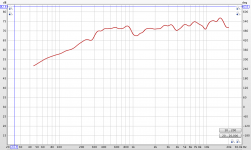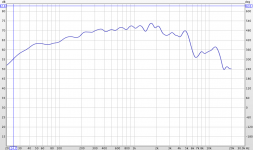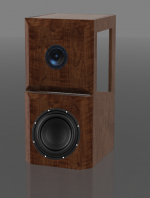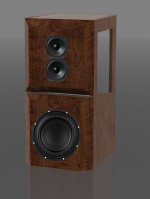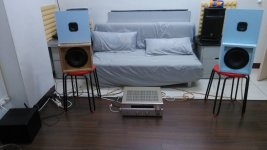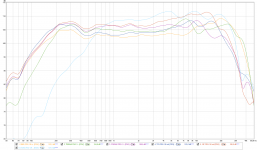Member
Joined 2009
Paid Member
There's been some recent interest in this speaker
did you ever try using a 1st order around the XO and then higher order further away ?
a kind of two-slope XO, the idea being to have the XO turn steeper to kill cone-break up on the woofer and be steeper to protect excursion on the full-range but around the XO region itself you avoid phase issues with the 1st order. The response of the individual drivers would already be down before the higher order kicked-in.
did you ever try using a 1st order around the XO and then higher order further away ?
a kind of two-slope XO, the idea being to have the XO turn steeper to kill cone-break up on the woofer and be steeper to protect excursion on the full-range but around the XO region itself you avoid phase issues with the 1st order. The response of the individual drivers would already be down before the higher order kicked-in.
No, but I never had any issues with needing a steeper slope for the filter. When I used active with miniDSP the Harsch XO uses 4th order on woofer and that was was nice but now that I am on 1st order passive - doesn't seem to be needed.
As the xo is at 600Hz and the cone breakup on the woofer is about 2400Hz, that's two octaves above the xo point giving -12dB attenuation if breakup.
Last edited:
The minDSP HD 2x4 is a very powerful and versatile piece of equipment, but when used as a cross-over, you must understand some limitations. Just as with a textbook speaker level passive XO, setting a canned XO will not guarantee the correct acoustic XO.
I don't know where your 10F rolls off at the low end. Mine is in a 1l moderately stuffed box and rolls of at ~ 250Hz BW12. That's the natural roll-off and is going to happen no matter what you do. Attempting a low order XO at 350Hz by selecting BW6 or Bessel in the miniDSP is simply not going to produce the results you expect. You will wind up with a 3rd or 4th order acoustic XO through most of the cut-off band.
I cheated a bit by choosing an XO point of 500Hz. Higher than what I would have liked, but about as low as I think doable to get reasonable attenuation in the cut-off band. But still -- I did not use the XO function of the miniDSP. I created the roll-off entirely with PEQ's to match the required target roll-off. How you create the targets is an issue for another post, but I can describe the basics here:
In the miniDSP, bypass all of the XO functions except one. In that output, select your required XO. Capture a screen shot. Open that screen shot it the graphic editor of your choice. Paint will do, but I prefer Irfanview. (Irfanview is superb for preparing images for posting to forums.) Save the image as a JPG. Use the curve tracer of your choice (mine is FPGraphTracer) to create an FRD file. Import that FRD into REW. Now you have a plotted target in REW and you can play with the PEQ's in the miniDSP to get your actual response to match the target.
Have fun.
Bob
I don't know where your 10F rolls off at the low end. Mine is in a 1l moderately stuffed box and rolls of at ~ 250Hz BW12. That's the natural roll-off and is going to happen no matter what you do. Attempting a low order XO at 350Hz by selecting BW6 or Bessel in the miniDSP is simply not going to produce the results you expect. You will wind up with a 3rd or 4th order acoustic XO through most of the cut-off band.
I cheated a bit by choosing an XO point of 500Hz. Higher than what I would have liked, but about as low as I think doable to get reasonable attenuation in the cut-off band. But still -- I did not use the XO function of the miniDSP. I created the roll-off entirely with PEQ's to match the required target roll-off. How you create the targets is an issue for another post, but I can describe the basics here:
In the miniDSP, bypass all of the XO functions except one. In that output, select your required XO. Capture a screen shot. Open that screen shot it the graphic editor of your choice. Paint will do, but I prefer Irfanview. (Irfanview is superb for preparing images for posting to forums.) Save the image as a JPG. Use the curve tracer of your choice (mine is FPGraphTracer) to create an FRD file. Import that FRD into REW. Now you have a plotted target in REW and you can play with the PEQ's in the miniDSP to get your actual response to match the target.
Have fun.
Bob
Thanks for the reply, Bob.
At the moment, I am using the miniDSP with my OB setup.
Would you then say that my chosen XO, being 300 on the W8-1772 (FR in red) and 350 on the 15" woofer (FR in blue) is too low? The graphs are taken as is, no EQ, no XO. The dBs are off as I didn't calibrate anything. But they are relative to both measurements.
I see the W8-1772 falling off naturally at 335Hz. I should choose something like 600Hz for XO?
At the moment, I am using the miniDSP with my OB setup.
Would you then say that my chosen XO, being 300 on the W8-1772 (FR in red) and 350 on the 15" woofer (FR in blue) is too low? The graphs are taken as is, no EQ, no XO. The dBs are off as I didn't calibrate anything. But they are relative to both measurements.
I see the W8-1772 falling off naturally at 335Hz. I should choose something like 600Hz for XO?
Attachments
perceval very good advice from Bob Brines there, is it understandable that if you wan't use textbook filters inside DSP unit you first have to EQ drivers curve smooth and flat there after cascaded a pre textbook filter you end up the right target that filter is named. In your new DSP can use corrections from free Rephase suggest you down the line study that freeware because it can do as above in first use its feature called "compensate" which flatten driver reasonable wide and then there after you set the right XO slopes, the enormous boost that "compensate" do to flatten driver is no problem as long as final driver pass-band when XO slopes is added are within drivers band-pass spec limits. Also Rephase can within 30 seconds create you any target curve you want to use as overlay for planning into REW, whatever you set in Rephase can be saved as 32bit mono IR-wav files and REW gladly import those for various presenting and manipulation use.
...So, you set the XO in Rephase? And import it into the FIR filter option of miniDSP?
Exactly and you have total control if XO slopes shall be minimum phase or linear phase, that is nice thing about your new unit have Shark FIR engine which can correct both IIR and FIR corrections or mix of both filter types into same uploading into unit.
So in practice into Rephase if you first compensate drivers with minimum phase (IIR) correction so they get a nice flat response and there after set XO slopes as linear phase you end up as the nice visual of the two shown back in post 818 if unit have enough headroom to handle the number of taps needed for your particular filters (which is easy to see into Rephase in that after generated it show real world correction as red color verse the textbook blue color and if they deviate too much down at low frq you asked too much time from your device that its number of taps can handle).
Think the hard thing to do in reality you know about : ) measurements needs some kind of windowing setting to be trust full base for actual in situation of system measurements and that can take a very long time to find from case to case, hints as waterfall starts look good or minimum phase curves start agreement measured absolute phase can be good clues.
@perceval
You are looking at the second reason I don't screw with OB's. You are looking at the dipole hump on the 1772. You need to control that, and I'm no expert on how. If you cross at 600Hz, you will loose a lot of the reason for using a wide-range driver -- phase rotation in the telephone band. Then, your 15" will need 15dB of boost to get to 30Hz. I know the 1772 has too low a Qts for OB, and I suspect that the 15" is also, but that looks like a nearfield measurement.
Oh, and the first reason is that I just don't like the comes-from-everywhere presentation of an OB, but that's just me. Press on!
Bob
You are looking at the second reason I don't screw with OB's. You are looking at the dipole hump on the 1772. You need to control that, and I'm no expert on how. If you cross at 600Hz, you will loose a lot of the reason for using a wide-range driver -- phase rotation in the telephone band. Then, your 15" will need 15dB of boost to get to 30Hz. I know the 1772 has too low a Qts for OB, and I suspect that the 15" is also, but that looks like a nearfield measurement.
Oh, and the first reason is that I just don't like the comes-from-everywhere presentation of an OB, but that's just me. Press on!
Bob
Ok, thanks for the heads up.
the 15" is a indeed higher Qts, at 0.78, Qms: 5.8.
I decided to work with the problem, instead of trying to fight it.
Borrowing on the Fast, Fun, Inexpensive OB thread, I am now using a 1st order on the 15" at 60Hz. Using the rising response of the woofer after 60Hz to keep it flat until further up.
Using the OB bump of the 1772 to match the woofer around that frequency range (needing to bring the 1772 down a bit by about 6dB, thus losing efficiency, that's the trade off), and adding a small BSC, I get a gentle downslope on the overall FR from 400Hz to 20kHz. XO on the 1772 is 1st order at 400Hz.
This was a quick test before the house came alive this morning, so I'll have to measure and tweak more, but so far it seems like a good trade off.
the 15" is a indeed higher Qts, at 0.78, Qms: 5.8.
I decided to work with the problem, instead of trying to fight it.
Borrowing on the Fast, Fun, Inexpensive OB thread, I am now using a 1st order on the 15" at 60Hz. Using the rising response of the woofer after 60Hz to keep it flat until further up.
Using the OB bump of the 1772 to match the woofer around that frequency range (needing to bring the 1772 down a bit by about 6dB, thus losing efficiency, that's the trade off), and adding a small BSC, I get a gentle downslope on the overall FR from 400Hz to 20kHz. XO on the 1772 is 1st order at 400Hz.
This was a quick test before the house came alive this morning, so I'll have to measure and tweak more, but so far it seems like a good trade off.
You don't need dual TC9's since sensitivity of your bass is no better than maybe 83dB. You will have to pad either. With dual TC9's you have a bit of vertical comb filtering and moving head up or down a few inches you can hear changes in volume - at larger distances not a problem. It's impressively loud at 92dB sensitivity in parallel though.
Alright...
Test bed for an upcoming build.
Should've gotten the miniDSP unit a long time ago. So easy to try different options.
But, I think I will try to get the 10F after all... it's a bit strange, but my TC9s can barely pass 10kHz.... I need to point them directly at me to get anything above 10k... then it drops like a brick after 12kHz or so...
I tried moving them around the room, from the back wall to all the way in the middle of the room. It impacts low end and around 7-8kHz, but nothing can bring the higher frequencies up... so I don't think it's cancelations.
Test bed for an upcoming build.
Should've gotten the miniDSP unit a long time ago. So easy to try different options.
But, I think I will try to get the 10F after all... it's a bit strange, but my TC9s can barely pass 10kHz.... I need to point them directly at me to get anything above 10k... then it drops like a brick after 12kHz or so...
I tried moving them around the room, from the back wall to all the way in the middle of the room. It impacts low end and around 7-8kHz, but nothing can bring the higher frequencies up... so I don't think it's cancelations.
Attachments
Hi Perceval,
That sounds as a error somewhere if TC9 barely can pass 10kHz, try in exactly same chain put a tweeter and it should also be limited. Have not miniDSP box myself but seen in a lot of posts from new owners where they get trouple if correction-file they upload to unit is not same rate unit is setup to and maybe that is what wrong here in that it cuts HF at half 22 or 24kHz because of sample rate mismatch somewhere.
If you ask me you don't win any HF with 10F verse TC9, you win some sensitivity, finesse in sound and bit sharper and beautiful IR, TC9 have better ventilation which should be better the lower XO point is, SS also have a 10F with better ventilation called 8414 and cheaper than 8424 but i don't no its sound and sensitivity also goes down. For prove see below test on same baffle under 192kHz chain (FDW1/6) which includes SB65WBAC25-4 / TEBM46C20N-4B / FF85WK / TC9FD18-08 / 10F/8424G00 and also a real 25mm tweeter DT254 from MONACOR.
That sounds as a error somewhere if TC9 barely can pass 10kHz, try in exactly same chain put a tweeter and it should also be limited. Have not miniDSP box myself but seen in a lot of posts from new owners where they get trouple if correction-file they upload to unit is not same rate unit is setup to and maybe that is what wrong here in that it cuts HF at half 22 or 24kHz because of sample rate mismatch somewhere.
If you ask me you don't win any HF with 10F verse TC9, you win some sensitivity, finesse in sound and bit sharper and beautiful IR, TC9 have better ventilation which should be better the lower XO point is, SS also have a 10F with better ventilation called 8414 and cheaper than 8424 but i don't no its sound and sensitivity also goes down. For prove see below test on same baffle under 192kHz chain (FDW1/6) which includes SB65WBAC25-4 / TEBM46C20N-4B / FF85WK / TC9FD18-08 / 10F/8424G00 and also a real 25mm tweeter DT254 from MONACOR.
Attachments
Thanks Byrtt, as always, you are very thorough with your replies.
Hmmm... ok, I'll bring the setup down to my main system and see if I can duplicate the problem.
I don't have a FIR file loaded to the miniDSP, so that would not be it.
The way I set it like in the picture above, using the Yamaha receiver, which has multi-channel inputs, I sent the outputs 1+2 to the main L/R, and the outputs 3+4 to the surround inputs of the receiver. I hooked the main L/R to the subs, and the TC9 were hooked to the surrounds output of the receiver. I don't think the receiver EQ the HF out of the surround speakers, but it's one thing I can test easily.
Hmmm... ok, I'll bring the setup down to my main system and see if I can duplicate the problem.
I don't have a FIR file loaded to the miniDSP, so that would not be it.
The way I set it like in the picture above, using the Yamaha receiver, which has multi-channel inputs, I sent the outputs 1+2 to the main L/R, and the outputs 3+4 to the surround inputs of the receiver. I hooked the main L/R to the subs, and the TC9 were hooked to the surrounds output of the receiver. I don't think the receiver EQ the HF out of the surround speakers, but it's one thing I can test easily.
Last edited:
That's why I used the surrounds for the fullrange, because I'm pretty sure they cut the bass out to send it to the sub, so I couldn't use them for my woofers. But maybe they also cut some of the HF, to not interfere with the mains L/R.
Hopefully, I'll find some time to test that theory tomorrow.
Hopefully, I'll find some time to test that theory tomorrow.
Member
Joined 2009
Paid Member
For prove see below test on same baffle under 192kHz chain (FDW1/6) which includes SB65WBAC25-4 / TEBM46C20N-4B / FF85WK / TC9FD18-08 / 10F/8424G00 and also a real 25mm tweeter DT254 from MONACOR.
That FF85WK looks pretty nice. They all look pretty smooth, would love to see plot with less smoothing applied. I had peaky-sibilance.
Hi Perceval,
That sounds as a error somewhere if TC9 barely can pass 10kHz, try in exactly same chain put a tweeter and it should also be limited. Have not miniDSP box myself but seen in a lot of posts from new owners where they get trouple if correction-file they upload to unit is not same rate unit is setup to and maybe that is what wrong here in that it cuts HF at half 22 or 24kHz because of sample rate mismatch somewhere.
If you ask me you don't win any HF with 10F verse TC9, you win some sensitivity, finesse in sound and bit sharper and beautiful IR, TC9 have better ventilation which should be better the lower XO point is, SS also have a 10F with better ventilation called 8414 and cheaper than 8424 but i don't no its sound and sensitivity also goes down. For prove see below test on same baffle under 192kHz chain (FDW1/6) which includes SB65WBAC25-4 / TEBM46C20N-4B / FF85WK / TC9FD18-08 / 10F/8424G00 and also a real 25mm tweeter DT254 from MONACOR.
Hi Byrtt,
You are collecting quite a collection of little full range drivers. :
Is this the FF85WK from our get together in Assen last year?
Hi Byrtt,
You are collecting quite a collection of little full range drivers. :
Is this the FF85WK from our get together in Assen last year?
Hi X yes warm thoughts from here its the drivers you gave me there
- Home
- Loudspeakers
- Full Range
- 10F/8424 & RS225-8 FAST / WAW Ref Monitor
